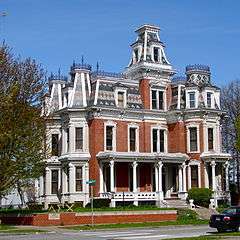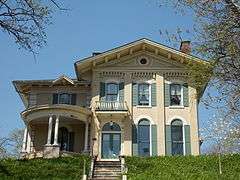J. Monroe Parker-Ficke House
|
J. Monroe Parker-Ficke House | |
 | |
  | |
| Location |
1208 Main St. Davenport, Iowa |
|---|---|
| Coordinates | 41°31′55″N 90°34′33″W / 41.53194°N 90.57583°WCoordinates: 41°31′55″N 90°34′33″W / 41.53194°N 90.57583°W |
| Built | 1881 |
| Architect |
T. W. McClelland Victor Huot |
| Architectural style | Second Empire |
| Part of | College Square Historic District (#83003628[1]) |
| MPS | Davenport MRA |
| Significant dates | |
| Added to NRHP | November 18, 1983 |
| Designated DRHP | June 4, 2003[2] |
The J. Monroe Parker-Ficke House is a historic home located in the College Square Historic District in Davenport, Iowa, United States. The district was added to the National Register of Historic Places in 1983.[1] The house was individually listed on the Davenport Register of Historic Properties in 2003.[2]
History
Built in 1881 by James Monroe Parker, a wealthy Davenport financier. It was designed and built by Davenport's prominent 19th-century builder T. W. McClelland. However, it is possible that Benjamin W. Gartside, who was an architect with the McClelland firm at the time, may be the actual designer.[3] Davenport architect Victor Huot is responsible for the slate roof. Since 1978 the building has served as a fraternity house for Delta Sigma Chi from the Palmer College of Chiropractic.
C.A. Ficke
The house is associated with Charles August Ficke (1850-1931), who was a prominent Davenport attorney, politician and developer.[4] Born in Beitzenburg, then in the Duchy of Mecklenburg, Ficke moved to Davenport as a young child in 1851. He became a lawyer in 1877 after reading in H.R. Claussen's office and formal study. Like many of people of German heritage between 1860 and 1885 he changed his political party affiliation from Republican to the Democratic Party.[3] In 1886 he was elected as the first Scott County attorney and then as Mayor of Davenport from 1890 to 1891. While he was mayor the city established the Public Works Department and LeClaire Park. Improved public works during his mayoral administration included street paving and sewer construction. He was the first mayor to veto an ordinance passed by the city council.[4] Ficke is also connected with several projects in downtown Davenport, including the Ficke Block, which is also listed on the National Register of Historic Places[5] His art collection was the nucleus that started the Davenport Museum of Art that is now housed in the Figge Art Museum.[4] Ficke's son, Arthur Davison Ficke, lived in the home during the latter half of his childhood before establishing himself as a nationally known poet.
Architecture
The two-story Brick house follows an irregular plan.[3] It features a mansard roof, multicolor slate shingles, wrought-iron roof cresting, brackets, moldings and fanciful window surrounds. The house is beautifully composed and well executed. It is the ultimate expression of Victorian excess, and it is considered one of the finest examples of Second Empire construction in the state of Iowa.[6]
References
- 1 2 National Park Service (2009-03-13). "National Register Information System". National Register of Historic Places. National Park Service.
- 1 2 Historic Preservation Commission. "Davenport Register of Historic Properties" (PDF). City of Davenport. Retrieved 2011-03-10.
- 1 2 3 Wehner, Nowysz, Pottschull and Pfiffner. "College Square Historic District" (PDF). Davenport Community Development Department - Iowa Division of Historic Preservation. Retrieved 2015-03-26.
- 1 2 3 "Charles August Ficke: An American Success Story". Davenport Public Library. Retrieved 2011-03-10.
- ↑ "Ficke Block" (PDF). Davenport Public Library. Retrieved 2011-03-10.
- ↑ Svendsen, Marls A., Bowers, Martha H (1982). Davenport where the Mississippi runs west: A Survey of Davenport History & Architecture. Davenport, Iowa: City of Davenport. pp. 2–5.

